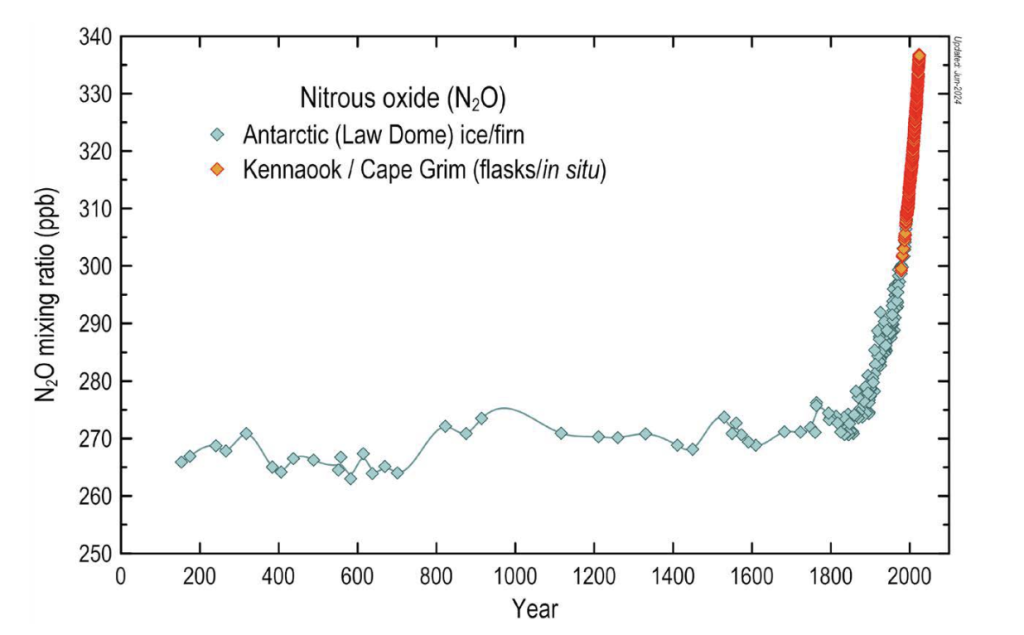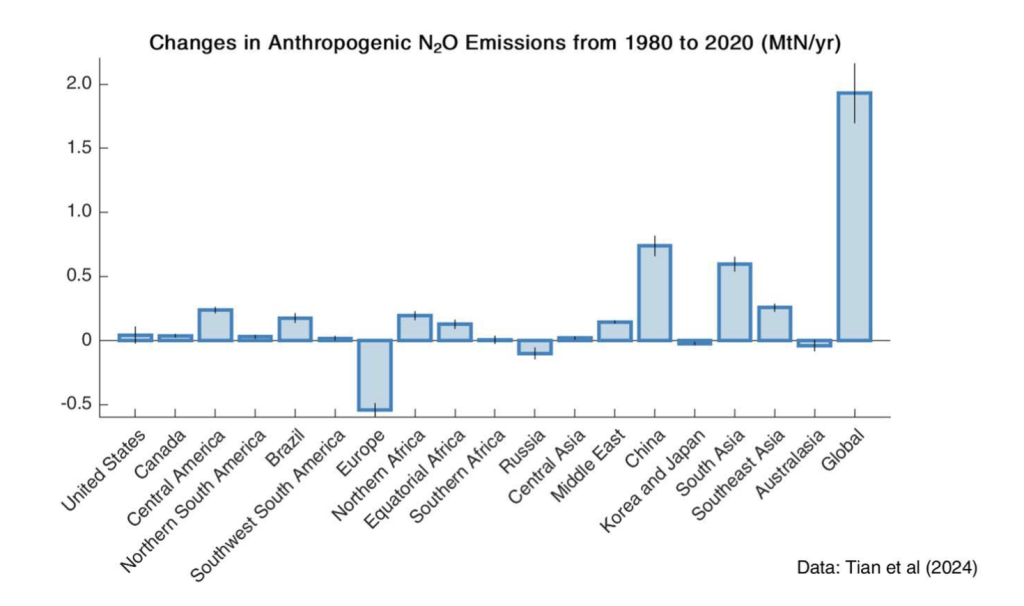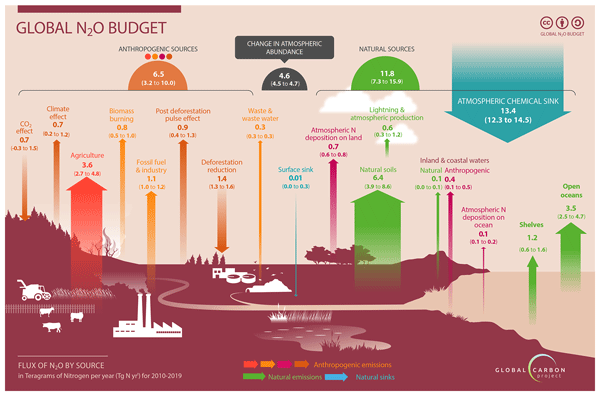Nitrous Oxide Emissions Accelerate Climate Change
Nitrous oxide emissions grew 40 percent from 1980 to 2020, accelerating climate change.
NOAA: Emissions of nitrous oxide, the third most important human-made greenhouse gas, rose 40 percent from 1980 to 2020, according to a new report by the Global Carbon Project. The new study, published today in the journal Earth System Science Data, finds nitrous oxide is accumulating in Earth’s atmosphere faster than at any other time in human history and its current growth rate is likely unprecedented in the last 800,000 years.
Nitrous oxide, or N20 is a long-lived, potent greenhouse gas that has been accumulating in the atmosphere since the pre-industrial era. Human-made emissions of N20 come mainly from applying nitrogen fertilizers and animal waste to farmland and pastures.
Concentrations of this potent greenhouse gas are higher than all major model projections.
N20is much less abundant in the atmosphere than carbon dioxide or methane (the two primary human-made greenhouse gases), but its global warming potential is nearly 300 times that of carbon dioxide over a 100-year time scale. N20 is also a strong ozone-depleting substance.
“The acceleration of atmospheric nitrous oxide growth in 2020-2022, as seen by NOAA’s global greenhouse measurements, are particularly concerning in this critical time when global greenhouse gas levels need to plunge,” said study co-author Xin (Lindsay) Lan, a CIRES scientist in NOAA’s Global Monitoring Laboratory (GML) who leads the reporting of greenhouse trends. “It is clear that we need to act fast to reduce greenhouse gas emissions to avoid the worst outcomes of global warming.”
While N20 is a small contributor to global warming compared to carbon dioxide, if N20 emissions continue at their current pace, it could make meeting climate goals challenging, according to the study authors.

This graph shows the dramatic increase in atmospheric nitrous oxide concentrations over the past 2,000 years. Nitrous oxide concentrations were relatively stable at around 270 parts per billion until 1750. Credit: Global Carbon Project.
Unprecedented growth
Ice core records show that N20 concentrations remained relatively constant at about 270 parts per billion over the past 2,000 years, but concentrations began going up around 1750.
GML researchers systematically measure and analyze concentrations of heat-trapping gases in air samples collected from around the globe. Analysis from GML’s Greenhouse Gas Reference Network shows N20 concentrations reached 336.7 parts per billion in 2023, an increase of about 25 percent since the pre-industrial era. N20 concentrations in the atmosphere are now higher than at any other time in the last 800,000 years, according to the latest report from the Intergovernmental Panel on Climate Change (IPCC).
In the new study, CIRES researchers in GML, along with scientists at other institutions who participate in the Global Carbon Project, updated the most comprehensive picture yet of the global N20 budget: an inventory of all the human and natural processes that produce and consume N20 and how those processes have changed over time. CIRES researchers are the main contributors to greenhouse gas measurements and tracking of global greenhouse gas trends at GML.
Using a combination of observations and computer models, including measurements made by NOAA, the researchers found N20 emissions have accelerated greatly in the last 40 years. By analyzing 21 sources and sinks of N20, they found emissions increased by 40 percent from 1980 to 2020. Direct measurements made at GML show N20 growth rates were higher from 2020 to 2022 than any previous years since 1980; the average growth rate in 2020-2022 was more than 40 percent higher than from 2010 to 2019.
China has had the largest increase in N20 emissions since 1980, while emissions from Europe have declined and emissions from the United States have stayed relatively stable over that time period, according to the study.

An overview of how nitrous oxide concentrations have changed globally and by region from 1980 to 2020. Credit: Global Carbon Project.
Emissions rising faster than ever
The study’s results show that N20 emissions are accelerating faster than at any other time in human history and have surpassed even the most pessimistic greenhouse gas projections used by the IPCC.
The major challenge to reducing human-made emissions of N20 is that fertilizers are essential for global food security. A significant portion of N20 emissions come from natural sources, like soils and the ocean, over which humans have no control. The new study emphasizes that the only way to slow the rate of increase is to reduce human N20 emissions because currently, no technology can remove it from the atmosphere.

An overview of the main sources and sinks of atmospheric nitrous oxide from 2010 to 2019. Credit: Global Carbon Project.
“Fundamentally, society needs to take drastic measures to reduce global warming by reducing the greenhouse gas emissions that are within our control,” Lan said.
About the Author: CLIMATE STATE
POPULAR
COMMENTS
- Robert Schreib on Electricity generation prices may increase by as much as 50% if only based on coal and gas
- Robert Schreib on China made a historic commitment to reduce its emissions of greenhouse gases
- Lee Nikki on COP30: Climate Summit 2025 – Intro Climate Action Event
- Hollie Bailey on Leaders doubled down on fossil fuels after promising to reduce climate pollution
- Malcolm R Forster on Mythbusters tests global warming theory – does CO2 warm air?